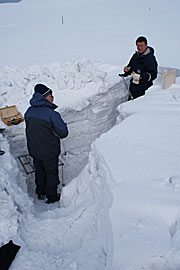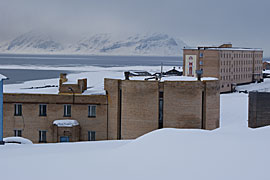From the edge of the world
As a deadline for claims to the Arctic nears, Alan Fisher visits Norway’s Spitsbergen.

 |
| What lies beneath the mining town of Longyearbyen is once again attracting international interest |
May 13 is the deadline for countries around the world to submit seabed ownership claims for the Arctic to a United Nations commission.
Al Jazeera visits the mining town of Longyearbyen, on the Norwegian island of Spitsbergen to speak to some of the inhabitants of “the land of the cold coasts”.
Keep reading
list of 4 itemsAfter the Hurricane
World’s coral reefs face global bleaching crisis
Why is Germany maintaining economic ties with China?
Longyearbyen is at the end of the world. It’s in the far north of Norway, deep inside the Arctic Circle, and is the world’s most northerly town.
| In depth |
|
|
A few people live further north, but they don’t have schools, or shops or hotels.
It is the main town on the island of Spitsbergen, part of the Svalbard archipelago, first mentioned in Icelandic texts more than 800 years ago as “the land of the cold coasts”.
At the beginning of the last century, Longyearbyen was a mining town and what lies beneath it is once again attracting huge international interest.
The Arctic is warming far faster than the global average, and as the polar icecaps begin to melt, it makes the Arctic’s hidden treasures more accessible.
It’s estimated that under the frozen landscape, there’s enough oil, and more particularly natural gas, to meet the world’s demands for three years.
Stretch that over the lifetime of an oil or gas well and suddenly it becomes clear why a number of countries are laying claim to huge swaths of the arctic.
Russian intent
Russia planted a flag in the sea bed at the North Pole in 2007 in a firm statement of intent.
 |
| The Arctic is warming far faster than the global average |
The Danes also claim the pole is theirs. The United Nations has set May 13, 2009, as a deadline in the race for the Arctic. By then, countries must outline how far they think their territory extends.
According to the Convention on the Law of the Sea, which lays down a comprehensive regime of law and order in the world’s oceans and seas, all coastal states automatically have a continental shelf stretching 200 nautical miles or 370km from the coast.
However, many countries, including Norway have continental shelves that extend further and so the UN will decide where the lines should be drawn.
Longyearbyen, home to about 2,000 people in total, is a pretty place with brightly coloured houses.
It now makes its money as a tourist attraction for people who enjoy winter activities and want to see the polar bears and also through its university.
Last wilderness
As the snow begins to fall, I walk with Dirk Notz, a German research scientist and an expert on the state of Arctic ice.
 |
| Notz is worried how the world’s last great wilderness could be changed by the race for oil |
He accepts temperatures are rising but he is worried that the world’s last great wilderness will be changed in the pursuit of the oil and gas deep below the surface.
He says: “If we allow drilling, open the shipping lanes, allow tourists to swamp previously inaccessible areas then the Arctic will become just another place on earth rather than something special.
“Those involved in profiting from global warming are never those who suffer from global warming.”
As we stand in the chill wind and bright light of late afternoon, we talk about our children and the legacy that will be left for them.
“In years gone by, countries exploited their colonies and drained their resources to make themselves richer. We are doing this now with the future,” says Notz.
He tells me that many of the world’s climate drivers originate at the poles and that over-development in the far north will lead to more Arctic ice disappearing, and that in turn will have an impact on climate change from Africa to Asia.
He says: “We have been talking about how we need money to fight this problem but there were never the funds to do anything substantial. Now Governments are producing billions of dollars in days.
“Governments see things only in three or four year election cycles. This needs a longer-term plan. We need to de-politicise the issue”.
Territory grab
Sixty kilometres south of Longyearbyen lies the Russian settlement of Barentsburg.
 |
| Mavludov, right, says Russians must remain on the island |
At this time of year, there is only one way for most people to get there and that is by snowmobile.
It takes more than two hours to drive through the Arctic wilderness where only the odd fisherman’s hut, weather station or reindeer herd breaks up the white horizon.
Barentsburg’s status is enshrined in a number of international agreements.
The Russians bought the land years ago and built a mine. It doesn’t make any proft and the number of people working underground has dropped but the number of scientists sent here by Moscow has increased.
Bulat Mavludov specialises in the study of glaciers and Arctic conditions.
He works from a fairly basic building at the edge of the town. He tells me the Russians have had a presence on the island for hundreds of years and it is important that they remain.
He understands the territory grab that’s going on, which he describes as “political” but believes there is little to suggest the area is awash with oil and gas. “The surveys don’t support this idea,” he says.
Polar bear warning
Across town, a statue of Vladimir Lenin, Russia’s former leader, looks out over the frozen fjord.
 |
| Barentsburg’s status is enshrined in a number of international agreements |
A short walk will bring you to the Russian consulate, the biggest building around, with the two headed eagle crest above the door.
Viacheslav Nikolaev has been the consul general here for three years and three months.
He tells me the history which protects this Russian enclave and diplomatically avoids answering when I ask who owns the North Pole, given the Russian flag planting there almost two years ago.
“Foreign policy is a matter for the president, the prime minister and the foreign minister. We have good relations with out Norwegian neighbours and that will continue,” he says.
Back in Longyearbyen it feels weird to walk out of a restaurant after 11pm and see the sun still high in the sky.
At our hotel, there is a warning that polar bears have been spotted around the edge of the town and there is a reminder not to leave the general area without an experienced guide who carries a rifle and a licence.
The temperature is creeping above freezing, the ice and snow on the streets is melting.
It’s a familiar change for the people here. They just don’t want it to be a permanent one.

 Gallery:
Gallery: